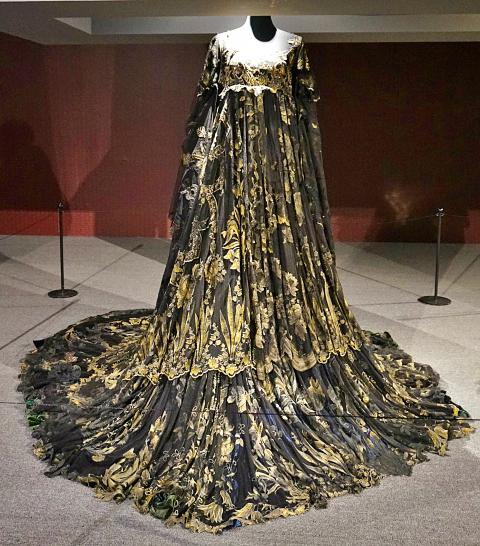Since Twilight hit the box office in 2008, primetime television has been overrun by images of sex-crazed, blood-sucking teenage vampires.
The latest exhibition at Taipei’s National Museum of History (國立歷史博物館), Dracula: History and Art of Vampires (德古拉傳奇:吸血鬼歷史與藝術特展) is refreshing in the sense that it strays from these types of over-saturated pop culture displays catering to emo tweens and their wannabes.
As with most art exhibitions, the focus is on creating ambiance. Displays are simply accompanied by matter-of-fact descriptions in Chinese and English listing names, dates and countries of origin, leaving viewers to believe whatever they wish to believe.

Photo: Dana Ter
Through showcasing literary texts to high fashion, the exhibition explores the historical influences which spawned modern day renditions of Dracula. Open to the public until Oct. 5 with tickets priced at NT$280, the exhibition does not just poke at people’s fantasies, but it is educational in the way it links various historical artifacts to contemporary pop culture.
COUNT AND COUNTESS
A series of old portraits, armors, maps and booklets in a dimly-lit room sets the mood for the rest of the exhibition which escalates in intensity. The feature piece is a 16th century oil painting of Vlad Dracula (1431-1476) who ruled Wallachia, or a region of present-day Romania. His patronymic and his cruel method of impaling enemies inspired Bram Stoker’s 1897 novel Dracula.

Photo: Dana Ter
Also on display are 16th century maps of Transylvania etched on copper, Turkish shields and Moorish masks worn at masquerade balls — all of which feed into preconceived notions of associating vampires with mystery and romanticism. On the other hand, historical documents including frayed booklets and handwritten dissertations from the 17th and 18th centuries on vampirism blur the lines between fact and folklore.
The exhibition places equal emphasis on highlighting the influence of Countess Elizabeth Bathory of Hungary (1560-1614), Vlad Dracula’s female counterpart. She is believed to have slaughtered countless numbers of young girls to bathe in their blood in order to retain her youth.
The myth surrounding the “Blood Countess” has inspired generations of fashion designers, and the exhibition certainly has no shortage of gothic dresses and winged costumes donated from European operas. The dresses range from matronly to seductive and somewhere in between.

Photo: Dana Ter
Female vampires are too often merely depicted in folklore as secondary in nature to Dracula, but the exhibition portrays them instead as active agents of their own, using their prowess (and impeccable fashion sense) to compete with male counterparts.
POP CULTURE MANIFESTATIONS
The original manuscript for Bram Stoker’s Dracula divides the historical and contemporary displays. Two of the feature displays in the contemporary section are Francis Ford Coppola’s original screenplay for the 1992 movie Bram Stoker’s Dracula and the red armor from the film designed by Ishioka Eiko.
Also noteworthy are photographs of Dracula-inspired men’s haute couture from capes and dark colors to lots of eye shadow. Dolce and Gabbana, Prada, Gucci and Alexander McQueen are among the big names.
Dracula’s legacy is not just confined to the Western world, though. The exhibition emphasizes Dracula’s influence in Japanese animanga as well, mostly through posters from the Blood Lad series created by Kodama Yuki and Don Dracula created by Tezuka Osamu.
Dracula: History and Art of Vampires manages to conjure up an alternate world without being too fantastical. Catering to history buffs and fashionistas alike, the displays are evocative of many “forbidden” human desires — including longing for immortality, the desire to love and be loved, and the ability to morph from good to bad come nightfall.

Most heroes are remembered for the battles they fought. Taiwan’s Black Bat Squadron is remembered for flying into Chinese airspace 838 times between 1953 and 1967, and for the 148 men whose sacrifice bought the intelligence that kept Taiwan secure. Two-thirds of the squadron died carrying out missions most people wouldn’t learn about for another 40 years. The squadron lost 15 aircraft and 148 crew members over those 14 years, making it the deadliest unit in Taiwan’s military history by casualty rate. They flew at night, often at low altitudes, straight into some of the most heavily defended airspace in Asia.

Beijing’s ironic, abusive tantrums aimed at Japan since Japanese Prime Minister Sanae Takaichi publicly stated that a Taiwan contingency would be an existential crisis for Japan, have revealed for all the world to see that the People’s Republic of China (PRC) lusts after Okinawa. We all owe Takaichi a debt of thanks for getting the PRC to make that public. The PRC and its netizens, taking their cue from the Chinese Communist Party (CCP), are presenting Okinawa by mirroring the claims about Taiwan. Official PRC propaganda organs began to wax lyrical about Okinawa’s “unsettled status” beginning last month. A Global

Taiwan’s democracy is at risk. Be very alarmed. This is not a drill. The current constitutional crisis progressed slowly, then suddenly. Political tensions, partisan hostility and emotions are all running high right when cool heads and calm negotiation are most needed. Oxford defines brinkmanship as: “The art or practice of pursuing a dangerous policy to the limits of safety before stopping, especially in politics.” It says the term comes from a quote from a 1956 Cold War interview with then-American Secretary of State John Foster Dulles, when he said: ‘The ability to get to the verge without getting into the war is

Like much in the world today, theater has experienced major disruptions over the six years since COVID-19. The pandemic, the war in Ukraine and social media have created a new normal of geopolitical and information uncertainty, and the performing arts are not immune to these effects. “Ten years ago people wanted to come to the theater to engage with important issues, but now the Internet allows them to engage with those issues powerfully and immediately,” said Faith Tan, programming director of the Esplanade in Singapore, speaking last week in Japan. “One reaction to unpredictability has been a renewed emphasis on